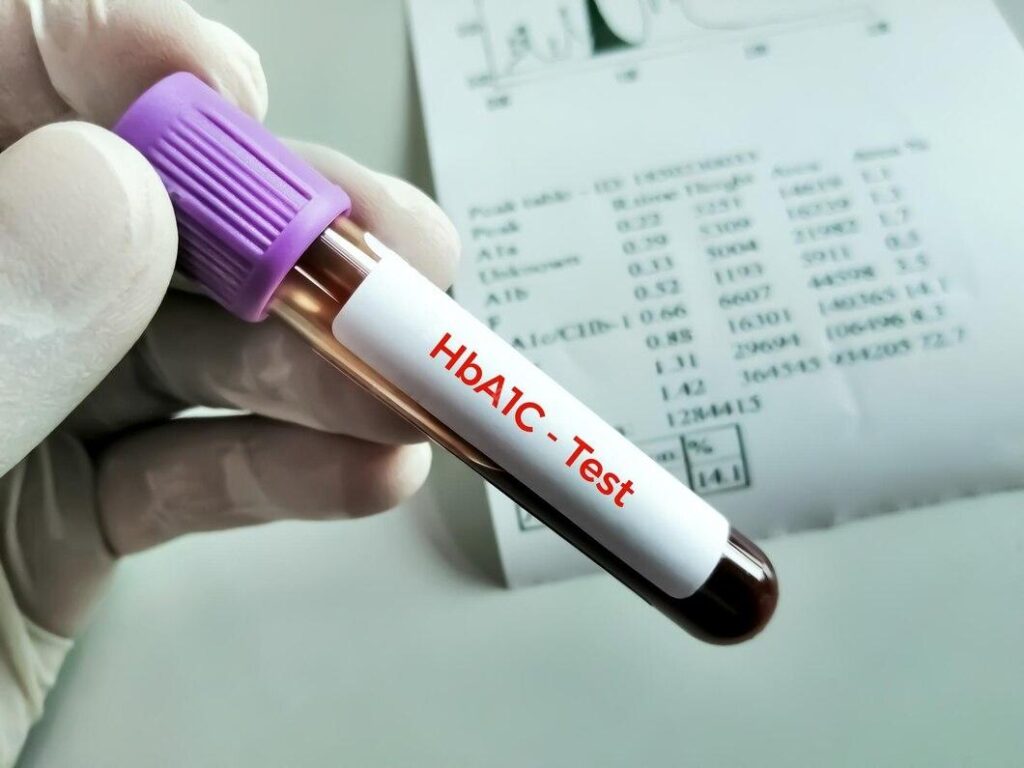HbA1c – Hemoglobin A1C Test;
What is HbA1c?
HbA1c, or glycated hemoglobin, is a measure of the average blood glucose levels over the past two to three months. It provides valuable insight into long-term blood sugar control.

What is an HbA1c Test?
An HbA1c test measures the percentage of hemoglobin that is glycated, or coated with sugar. It is a simple blood test that requires a small sample, usually obtained from a finger prick or a vein in the arm.
What is Hba1c Test Used For?
HbA1c is a good test and has many purposes like if you are being suspect of diabetes, then this test will help in diagnosis. Similarly, if you are receiving treatment of diabetes, then HbA1c will help in evaluating treatment efficiency. Let’s know more;
1. Monitoring Blood Sugar Control
- The primary use of the HbA1c test is to monitor blood sugar control over time.
- By measuring the percentage of glycated hemoglobin in the blood, the HbA1c test provides insight into average blood sugar levels over the past two to three months.
- Regular HbA1c testing allows healthcare providers to assess the effectiveness of diabetes management strategies and make necessary adjustments to treatment plans.
2. Diagnosing Diabetes and Prediabetes
- In addition to monitoring, the HbA1c test is also used for diagnosing diabetes and prediabetes.
- A diagnosis of diabetes is typically made if HbA1c levels are 6.5% or higher.
- HbA1c levels between 5.7% to 6.4% indicate prediabetes, a condition characterized by elevated blood sugar levels that may progress to diabetes if left untreated.
3. Assessing Risk of Complications
- Elevated HbA1c levels are associated with an increased risk of diabetes-related complications, such as cardiovascular disease, kidney disease, nerve damage, and eye problems.
- Regular monitoring of HbA1c levels allows healthcare providers to assess the risk of complications and intervene promptly to mitigate risks.
4. Guiding Treatment Decisions
- The HbA1c test plays a crucial role in guiding treatment decisions for individuals with diabetes.
- Based on HbA1c results, healthcare providers can adjust medication dosages, prescribe new medications, or recommend lifestyle modifications to optimize blood sugar control.
- Treatment goals are often tailored to individual HbA1c targets, taking into account factors such as age, comorbidities, and overall health status.
5. Evaluating Treatment Efficacy
- Beyond guiding initial treatment decisions, the HbA1c test is used to evaluate the efficacy of diabetes management strategies over time.
- Regular monitoring of HbA1c levels allows healthcare providers to assess whether treatment goals are being met and make adjustments as needed to achieve optimal blood sugar control.
- Trends in HbA1c levels provide valuable feedback on the effectiveness of medication regimens, dietary changes, exercise programs, and other interventions.
How to Prepare for an HbA1c Test
There is typically no special preparation required for an HbA1c test. However, it is important to follow any instructions provided by your healthcare provider, such as fasting requirements or medication adjustments.
What is Normal Range of HbA1c Test Results?
- Normal Range: A normal HbA1c level is below 5.7%.
- Prediabetes Range: HbA1c levels between 5.7% to 6.4% indicate prediabetes.
- Diabetes Range: HbA1c levels of 6.5% or higher are indicative of diabetes.
How to Lower HbA1c?
Lowering HbA1c levels is essential for managing diabetes and reducing the risk of complications. Strategies include:
- Medication: Follow prescribed medications, such as insulin or oral medications, as directed by your healthcare provider.
- Diet: Adopt a balanced diet rich in fruits, vegetables, lean proteins, and whole grains. Limit intake of sugary and processed foods.
- Exercise: Engage in regular physical activity, such as brisk walking, cycling, or swimming, for at least 150 minutes per week.
- Blood Sugar Monitoring: Monitor blood sugar levels regularly and adjust treatment as needed under the guidance of your healthcare provider.
What is Normal HbA1c by Age?
HbA1c targets may vary depending on individual factors, including age and overall health. However, in general:
- For adults with diabetes, the target HbA1c is typically below 7%.
- For older adults or those with comorbidities, higher targets may be considered to avoid hypoglycemia and other complications.
How to Lower HbA1c Naturally?
- Healthy Lifestyle: Embrace healthy habits, such as eating a balanced diet, exercising regularly, managing stress, and getting adequate sleep.
- Weight Management: Achieve and maintain a healthy weight through a combination of diet and exercise.
- Hydration: Stay hydrated by drinking plenty of water throughout the day.
- Limit Alcohol and Quit Smoking: Reduce alcohol consumption and quit smoking to improve blood sugar control.
Read More:

